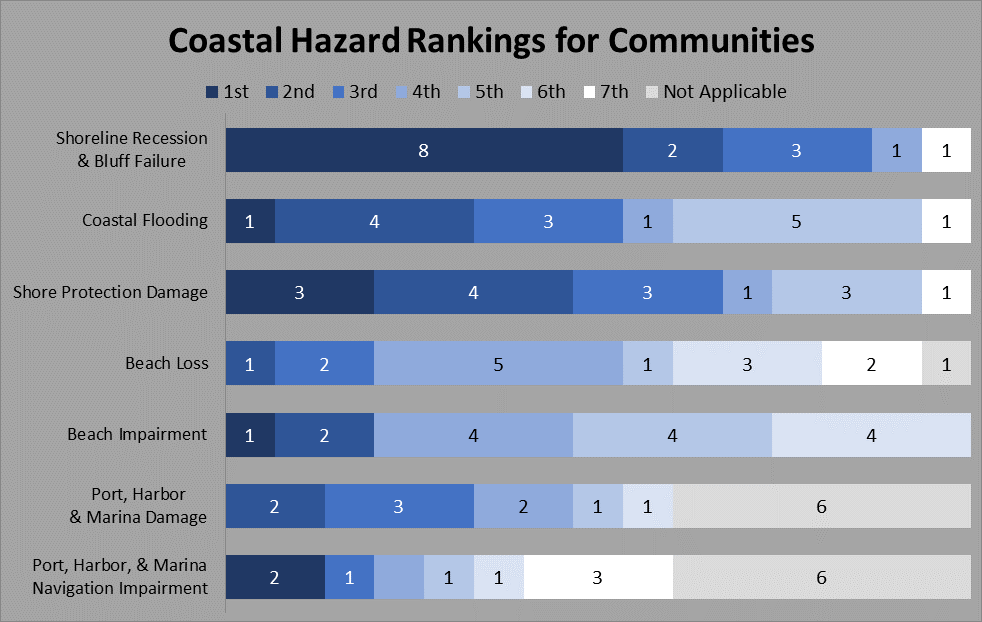
Southeastern Wisconsin’s Opportunities to Increase Coastal Resilience
A Coastal Resilience Self-Assessment was provided to staff and decision-makers of Southeastern Wisconsin’s coastal counties and municipalities to help them weigh the effects of coastal hazards and begin to consider planning and mitigation actions which may increase the coastal resilience of their community. This Self-Assessment consisted of two main parts: a rating system to identify top coastal hazard risks and a questionnaire to identify resilient practices. The Self-Assessment is available online. If you haven’t had a chance to use the Self-Assessment, it’s never too late! Let us know if you are interested in working through it and we’d be happy to help.
A total of 13 communities completed the full self-assessment and 2 communities completed only Part 1. Community responses were used to help identify resilience opportunities in the individual communities. This blog aggregates the responses of each community to provide a summary snapshot of the region’s coastal resilience opportunities.
Part 1: Identifying Coastal Hazard Risks
Each community rated various coastal hazards as either “high”, “medium”, or “low” in three categories:
- Probability = The likelihood that a hazard is expected to occur
- Impact = The extent to which a hazard can cause injury, property damage or service interruption
- Preparedness = The level of planning or action that has taken place to reduce the impact of the hazard
A “risk score” was calculated from these ratings to rank the relative importance of different hazards in each community. Shown below is a summary of how each hazard ranked based on the calculated risk score.

Shoreline Recession and Bluff Failure were by far the top hazard of concern across the region, ranking as the number one hazard by risk score for a majority of the communities. A big contribution to this result was the fact that over half of the communities indicated a “Low” level of preparedness for shoreline recession and bluff failure. Other top rated hazards by risk score were Coastal Flooding and Shore Protection Damage.
Learn More About Hazards: Living on the Coast is a booklet that describes natural coastal processes, how these processes can lead to hazardous conditions and strategies to manage risk to coastal properties.
Part 2: Resilient Practices Questionnaire
Respondents answered a series of 40 yes/no questions to help identify common planning and mitigation actions that their community could implement to address coastal hazard issues. Below are the top eight questions that had the most “No” or “Unsure” answers, indicating some common opportunities throughout the region that communities could pursue to improve their resilience to coastal hazards. Each featured question has a link to a resource to learn more about the opportunity. A full list of relevant resources for each topic in the self-assessment can be found in the Coastal Resilience Self-Assessment Appendix.
Areas of Opportunity
| Are there estimates of future financial losses due to coastal hazards? (Q3) |  |
| Learn More: A case study detailing one method to estimate loses from Great Lakes coastal hazards in Grand Haven, MI is available from Resilient Michigan | |
| Have strategies from the local Hazard Mitigation Plan been implemented as described? (Q8) |  |
| Learn More: A Guide to Hazard Mitigation Planning for Wisconsin’s Coastal Communities describes how to identify, profile and mitigate coastal hazards in a Hazards Mitigation Plan. | |
| Do plans for public infrastructure include recommendations for relocation, abandonment, or protection for at-risk infrastructure? (Q14) |  |
| Learn More: Managing Coastal Hazard Risks on Wisconsin’s Dynamic Great Lakes Shoreline describes a set of strategies for managing the risks to coastal development. | |
| Are ordinances pertaining to coastal hazards consistent in policy and language with surrounding jurisdictions? (Q19) |  |
| Learn More: Coastal Ordinance Provisions in Wisconsin Communities reviews county and municipal ordinances in Wisconsin that can help reduce the risks to coastal development. | |
| Is outreach focused on coastal hazard issues conducted for coastal residents? (Q20) |  |
| Learn More: A good starting point for residents is Living on the Coast, a booklet which describes natural coastal processes and strategies to manage risk to coastal properties. | |
| Are shore protection structures routinely inspected and maintained? (Q25) |  |
| Learn More: Ohio Coastal Design Manual demonstrates how common Great Lakes coastal structures are designed, with a focus on Inspection and Maintenance in Section 4.4 | |
| Are you aware of instances where shore protection structures adversely impacted adjacent shorelines? (Q26) |  |
| Learn More: Great Lakes Shore Protections Structures is a fact sheet that describes shore protection structures and their effects, both positive and negative, on the shoreline. | |
| Does your community have a stormwater management plan with a section related to water management along the coast? (Q32) |  |
| Learn More: Stabilizing Coastal Slopes on the Great Lakes describes the importance of proper stormwater and groundwater management to stabilize slopes. | |




